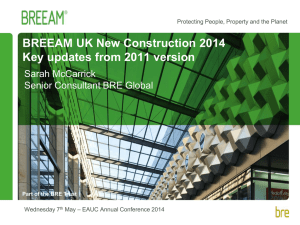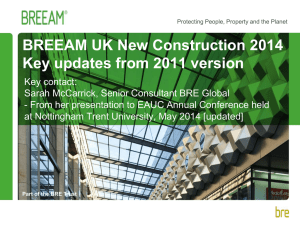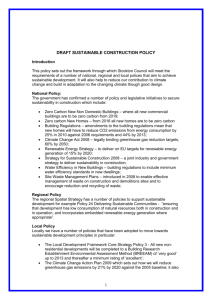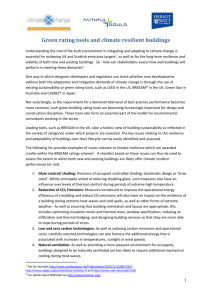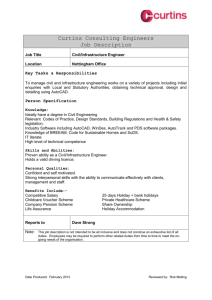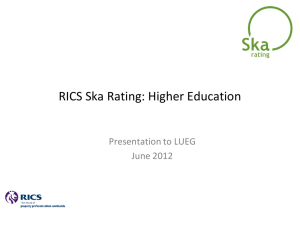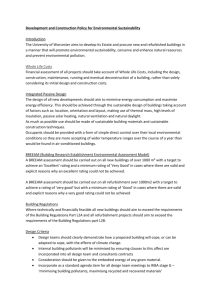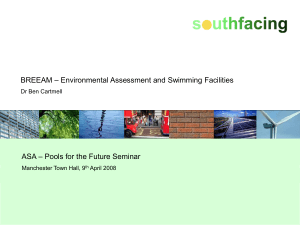BREEAM Schools Alan Pither Clare Lowe
advertisement
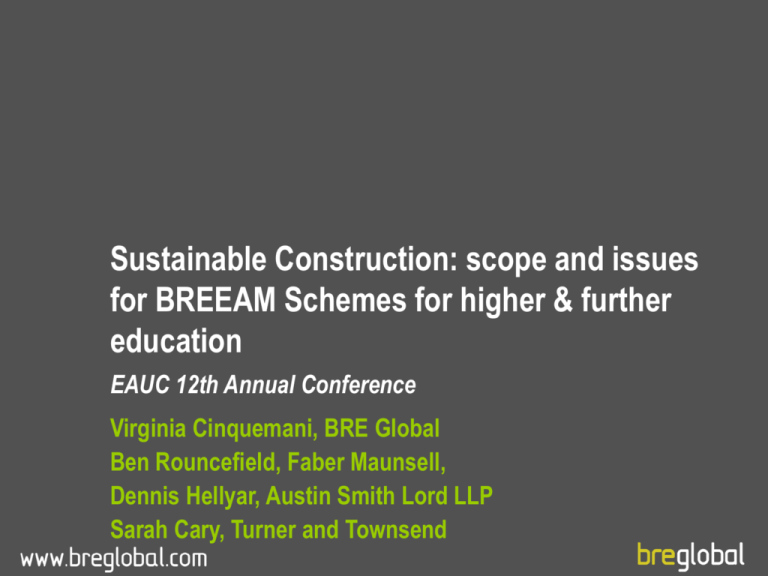
Sustainable Construction: scope and issues for BREEAM Schemes for higher & further education EAUC 12th Annual Conference Virginia Cinquemani, BRE Global Ben Rouncefield, Faber Maunsell, Dennis Hellyar, Austin Smith Lord LLP Sarah Cary, Turner and Townsend Summary • Sustainable development • What is BREEAM • BREEAM’s aims • Issues covered • The assessment process and costs involved • BREEAM FE and HE • Brainstorming exercise on HE • Case Studies: Pembrokeshire College and University Campus Suffolk Building What is Sustainable Development? Economic Success Sustainable Development Economic Loss Local issues • Images here • BRE Environmental Assessment Method for buildings • Nationally and internationally recognised • Updated annually in line with best practice and legislation • Independent • Certification scheme • Credit based • ISO9001 / UKAS accreditation References to Industry Guidance and Codes • CIBSE: ventilation rates, lighting levels, legionellosis, thermal comfort, energy modelling, commissioning. • HVCA: Maintenance and commissioning requirements. • Environment Agency: Pollution, ecological protection. • BSRIA/CIRIA/BRE: Commissioning regimes; Construction site management; Construction waste, construction materials, energy management • Considerate Constructors Scheme and other similar independently auditable schemes • FSC/PEFC: Timber certification Regulatory minimum Number of buildings Mass market Minimal Environmental Standards Aspirational What is BREEAM? Which building types can be assessed? • Homes • Crown Courts • Offices • Shopping Malls • Job Centres • Light Industrial Buildings • Heavy Industrial Buildings • Schools / FE • Health Buildings • Sports Facilities • Prison House Blocks • Libraries Types of BREEAM Assessments Scheme D&P Fit-Out PCR M&O Offices Schools Retail Industrial Healthcare Bespoke The stages of the BREEAM assessment • Covers: • New build • Major refurbishments, i.e. building works that would significantly change the environmental performance of the building, like changing the windows, substituting part of the fabric, adding insulation, changing the services • Extensions • Existing buildings in operation BREEAM Issue Categories • Management • Energy • Health & Wellbeing • Transport • Materials • Water • Waste • Land Use & Ecology • Pollution BREEAM Scoring • Management • Water • Materials • Waste • Land Use and Ecology • Pollution Single Score • Transport Environmental Weightings • Energy Issue Category Scores Assessment Credits • Health and Wellbeing BREEAM Score PASS GOOD VERY GOOD EXCELLENT OUTSTANDING 30% 45% 55% 70% 85% Environmental Weightings BREEAM Weightings • Management 12 • Health & Wellbeing 15 • Energy 19 • Transport 8 • Water 6 • Materials 12.5 • Waste 7.5 • Land Use & Ecology 10 • Pollution 10 Any questions? Management • Effective Building Operation – – – – – – – – – – Commissioning Construction Impacts User Guide Life Cycle Analysis Publication of Building Information Shared Facilities Development as a Learning Resource Maintenance Consultation Security Health and Wellbeing • Indoor Environment – – – – – – – View out Thermal Comfort Natural and Artificial Lighting Air Quality Acoustics Microbial Contamination Drinking Water • Occupant Control • Occupant Satisfaction Energy • Reducing CO2 Emissions – NCM’s kgCO2/m2 calculation • Activity • Geometry • Construction / Materials • HVAC systems • Hot water • Artificial / natural lighting • Renewable energy sources – Improvement above Part L2 of Building Regs – Linked with EPBD and DEC • Sub-metering of energy • External lighting Transport • Reducing CO2 Emissions from travel – – – – Access to Public Transport Cycling Facilities Pedestrian and cyclist safety Green Travel Plan Water • Reducing Water Consumption – – – – Low water consumption fittings Water recycling Metering Leak detection – Maintenance Materials • Reducing Material Use – Reuse of Structure / Façade – Designing for Robustness • Reducing the Impact of Materials – Timber/Glass/Concrete/Insulation… – Key Building Elements Waste • Recyclable Waste – Storage recyclable waste – Aggregates / Construction Waste Land Use and Ecology • Brownfield / Contaminated Land – Reuse of land • Ecology – – – – Ecological enhancement Ecological value Local Wildlife Partnerships Consultation with Students and Staff • Protection of Ecological Features – Long term impact Pollution • Minimising Harmful Pollutants – – – – Refrigerants Insulation NOx Emissions Renewable and low CO2 Emission Energy Sources – Flood risk – Watercourse Pollution – Night Light Pollution Any questions? Assessment Process Independent Licensed Assessors Builder, Developer, Owner, Occupier Assessment Process Independent Licensed Assessors Builder, Developer, Owner, Occupier Pre-BREEAM Advice Formal Assessment Assessment Process Independent Licensed Assessors Builder, Developer, Owner, Occupier Consensus Standard Pre-BREEAM Advice Quality Control Formal Assessment Assessment Process Independent Licensed Assessors Builder, Developer, Owner, Occupier Consensus Standard Quality Quality Control Control Pre-BREEAM Advice Formal Assessment Issue Certificate How do you get the higher BREEAM ratings? • • • • • Early Forward planning Know BREEAM Build relationships Capitalise on project opportunities – Cost effective credits – Consider weighting • Takes time • Pre-Assessment Estimator BREEAM The price of sustainable schools • BRE and Faithful+Gould – funded by BRE Trust and DCSF • Information Paper IP 1/08: ‘The price of sustainable schools: how much does it cost to achieve BREEAM schools ratings?’ • Summary of the capital cost implications of achieving BREEAM Schools ratings and low/zero carbon for: – Primary school – Secondary school • IP now available from BRE bookshop £9 www.bre.co.uk/brebookshop Summary of results • Percentage increase in capital cost to achieve a BREEAM Schools rating: Pass Good Very Good Excellent Zero/low carbon Primary school 0 – 0.2 0.5 – 0.8 1.4 – 2.5 4.5 – 7.6 2.1 – 9.8 0 – 0.1 0.2 – 0.7 1.0 – 2.6 4.1 – 5.6 2.7 – 15.3 Secondary school Putting a price on sustainable schools • Publication FB15: ‘Putting a Price on Sustainable Schools’ • Detailed outline of capital cost per BREEAM Schools credit and cost of low/zero carbon solutions for two case studies: – Primary school – Secondary school • Available April 2008 Any questions? Scope of BREEAM FE • All further education / adult / vocational colleges, standalone sixth form buildings and 14-19 schools with vocational facilities. • The LSC has stated: ‘To qualify for LSC capital funds all proposals will need to address Sustainable Development by ensuring that the completed development meets the criteria to achieve 'Very Good' Building Research Establishment Environmental Assessment Method (BREEAM) rating.‘ Further Education Tool Credit Criteria Function Areas Applicability of the credits: whole site / function area BREEAM update 2008 • From May ‘08, BREEAM Schools and BREEAM FE will be incorporated in one scheme, BREEAM Education • Filtered credits • One assessment tool / one manual • This might also include BREEAM HE – when developed Pembrokeshire College BREEAM – Bespoke Assessments • Area weighted – Whole building credits are most valuable and offer best value – Specific ‘Area’ credits can often be of low value – FMSDG identified the ‘best value’ credits to be targeted – Now to be BREEAM FE – semi Bespoke – still area weighted BREEAM – The important bit • Every credit must be robustly evidenced before it can be awarded • Design Team & Client responsible for providing evidence for all credits to be pursued • Pembrokeshire College evidenced in 3 weeks! Excellent Wasn’t easy! • • 100% of credits weren’t available Several site related BREEAM credits not fully achievable – Transport Links – didn’t fit the BREEAM mould – Ecology – not contaminated! • Some BREEAM credits not available due to the design/specification – Re-used Facades & Structures – Pollution (NOx) Pembrokeshire College – How Excellent was achieved Highly sustainable basic design • • • • • Low energy use and renewables Water efficient Re-use of land Good location Good contractor Additional Requirements • • • Ecology Further water efficiencies Transport Pembrokeshire College Construction Technology Centre Presentation to EAUC Dennis Hellyar Architect Key Facts Construction Technology Centre • Client: Pembrokeshire College • Brief: Construction Technology Centre – • • • • Site defined as Part of Masterplan Create flexible learning environment accommodating Carpentry and Brickwork Environmentally Sustainable Building Benchmark for future buildings • Size: 2023m2 (net) • Budget: £2.9M • Funding: 70% from WAG & Department of • Breeam: Bespoke assessment - Business Enterprise and Regulatory Reform’s Low Carbon building programme Achieved - Excellent (72.54%) – First in England & Wales in FE sector to achieve • Procurement: Traditional The Functions Construction Technology Centre • • • • • • • • • Brick Workshop – Internal & External Carpentry Workshops Project Rooms Machine Workshop Offices Classrooms Resource Rooms Storage Toilets Overview – Key Environmental Features Construction Technology Centre • • • • • • • • • • • • • Maximised Natural Lighting Limited mechanical ventilation Water use – harvesting & conserving Green Guide A Rated Materials No AC = No Refrigerants ‘Medium’ level Renewables Lighting Control System Building Management System FSC certified Timber Insulants: ODP – zero; GWP<5 25% improved U values Improved Ecology – Increased Indigenous Species Green Travel Plan – Public Transport and improved cycling facilities Green Strategy – Breeam Wins Construction Technology Centre • Water Section: - Low Flush Toilets - Waterless Urinals - Rainwater Harvesting - Passive Infra Red detection on taps - Solenoid valve shut off to WC’s not in use - Minimal Irrigation of plants - Water metering - Leak detection • Energy: - 29% Total Building Energy supplied by biomass (renewable energy source) - 3% Total Building Energy supplied by Solar Thermal System - BMS controls thermal zoning for varying occupancies • Management: - Registered with CCS - Building User Guide - Pre seasonal specialist commissioning - key stakeholder consultation Breeam - Excellent Construction Technology Centre University Campus Suffolk University Campus Suffolk Academic Building Sarah Cary Management, Water & Waste High level of site management specified of the Contractor. Client commitment to consultation and publication of information. Water Leak Detection system through BMS. Significant space for recycling storage of as part of campus recycling programme. Energy, Pollution & Ecology Sedum Roof attenuates water & contributes to the ecological value of the site. Focus on lighting and thermal comfort control & zoning reduced overheating and electricity use. Predicted 6.99% improvement in Carbon Emissions beyond the Part L Building Regulations Requirement. Air conditioning with leak detection system. Super Low NOx (nitrous oxide) Boilers Key Lessons Start Early Client Commitment Campus-Wide Future-Proof What other elements / issues would you cover in a Higher Education environmental assessment? • Some issues to be considered: Specific functions: Laboratories, others? Transport patterns – open longer hours? Car parking Use of facilities for conferences, lectures, etc? Commercial scale catering facilities Campus-wide issues Others…? Communication • BREEAM Office • Email : breeam@bre.co.uk • Phone : 01923 664 462 • Post : BRE, Garston, Watford, WD25 9XX • Web: www.breeam.org
